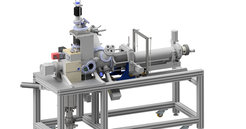Chemical Dynamics at Surfaces Using Ultra-Short Atom Pulses
Kai Golibrzuch leads a group aiming to probe chemical dynamics at surfaces applying intense sub-nanosecond atom pulses.
Ultra-short light pulses have become invaluable in time-resolved studies in chemistry and physics and processes that occur on a sub-picosecond time-scale can be resolved. However, many important processes are initiated by collisions. While lasers have revolutionized experiments using light pulses, experimentally proven concepts for producing ultra-short pulses of neutral matter are still in their infancy. This has direct impact on our ability to control the exact time of a collision.

Short atom pulses can be created by photolysis of diatomic molecules. For example, irradiation of HI molecular beams with UV laser pulses in the range from 190-300 nm produces hydrogen atom pulses with a speed of up to 25 km/s. Using narrow bandwidth nanosecond lasers, the duration of these pulses is limited to the pulse duration of the laser (10ns…20ns) applying tight focusing. However, tight focusing causes a small photolysis volume limiting the number of molecules available for dissociation. Therefore, experiments generally use larger photolysis volumes increasing the practical pulse durations to at least 100ns, which is beyond the time-resolution needed to resolve the dynamics of a system.


In our experiments, we use ultra-fast lasers for photolysis and bunch-compression photolysis, a technique developed in our department recently [1]. The proof-of-principle experiments already produced H-atom pulsed with 5ns duration, deconvolution of laser based ionization lead to an estimate of 1.2 ns true pulse duration. The method applies an ultra-short femtosecond laser pulse for photolysis of jet-cooled HI. The wavelengths of the broadband laser pulses are spatially ordered in way that the H-atom pulse compresses after a defined distance due to the large spread in velocity. The usage of a spatial chirp increases the photolysis volume and therefore the method generates high intensity H-atom pulses even for short pulse durations.
The goal of our work to use the concept of bunch compression photolysis and apply the short H-atom pulses to study kinetics and dynamics at surfaces on a sub-ns time scale. We use ultra-short pulse amplification in a KrF excimer discharge to amply our µJ photolysis pulses up to >20mJ. This allows use to produce high intensity short H-atom pulses applicable in surface scattering experiments. First experiments of H-atom scattering off single-crystal graphene were successfully performed. Currently, we are implementing H-atom scattering in combination with picosecond laser excitation of the surface.
References: [1] Kaufmann, S., Schwarzer, D., Reichardt, C., Wodtke, A. M., & Bünermann, O. (2014). Generation of ultra-short hydrogen atom pulses by bunch-compression photolysis. Nature Communications, 5: 5373. doi:10.1038/ncomms6373.

This project has received funding from the European Research Council (ERC) under the European Union's Horizon 2020 research and innovation programme.
(Grant Agreement: 742422 - HBEAM - ERC-2016-ADG)



